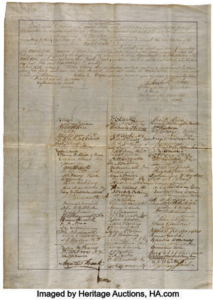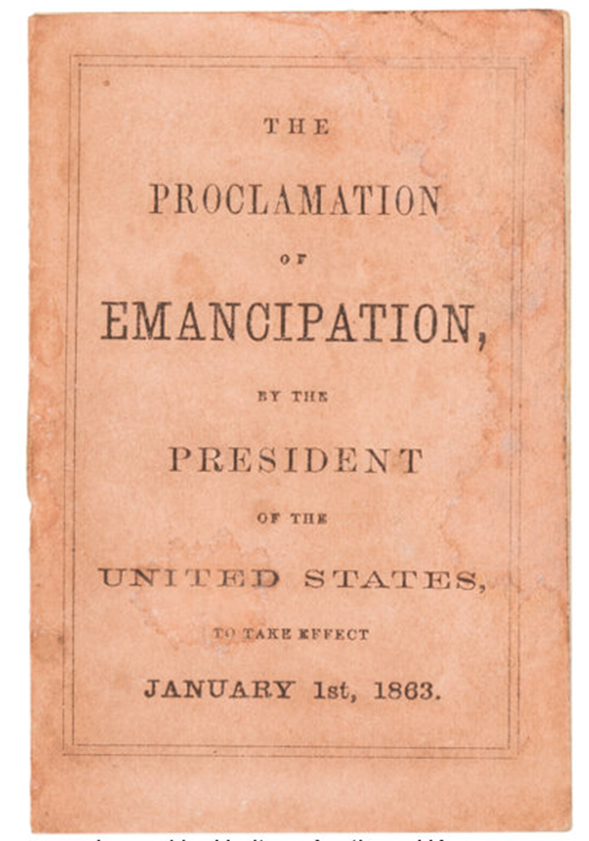By Erick Johnson
It officially outlawed slavery years after hundreds of thousands of Blacks in the South were declared free when Abraham Lincoln’s Emancipation Proclamation sparked what is today the annual Juneteenth holiday.
Today, an original, 157-year-old, historic copy of the Thirteenth Amendment is being auctioned online by Heritage Auctions in Chicago’s River North neighborhood. The auction is open to buyers who can bid online. The opening bid is $200,000. The last day to bid on the document is February 11.
The auction house does not identify the seller or say how it obtained the rare copy.
Heritage Auctions sells many post-Civil War items with ties to Congress and America’s 16th President Abraham Lincoln. Some are sold for hundreds of thousands of dollars.
In 2019, it sold a rare preliminary version of President Abraham Lincoln’s Emancipation Proclamation that was published in December 1862, less than a month before the historic declaration was made. The document sold for an undisclosed amount, but the current owner welcomes fresh offers over $21,562.
But Heritage Auctions’ copy of the Thirteenth Amendment may fetch a much higher price.

Like other items up for auction, the copy of the Thirteenth Amendment is posted on Heritage Auctions’ website. Heritage Auctions said its copy of the Thirteenth Amendment is on parchment paper and marked “Duplicate” at the heading. It’s signed by then Speaker of the House of Representatives Schuyler Colfax, Vice President Hannibal Hamlin and over 107 members of the 38th Congress, including future U.S. President James Garfield.
The Thirteenth Amendment was passed by Congress on January 31, 1865. President Lincoln signed the document on February 1, 1865, three months before he was assassinated by John Wilkes Booth at Ford’s Theater in Washington, D.C.
The amendment was ratified by 27 of 36 states on December 5, 1865. Illinois Congressman and Civil War General John Franklin Farnsworth also signed the historic document. Illinois Congressman Jesse Olds Norton’s signature is also on the document.
Four faint signatures of members of the Senate, including Charles Sumner and John P. Hale, are written on the left margin.
Titled, “The Historic Thirteenth Amendment to the Constitution: Abolishing the Institution of Slavery,” the document reads, “Neither slavery nor involuntary servitude, except as a punishment for crime whereof the party shall have been duly convicted, shall exist within the United States, or any place subject to their jurisdiction. (Amendment xiii, Section 1)”.
The Emancipation Proclamation and the 13th Amendment to the Constitution are among the most important documents in U.S. history.
They are significant events in Black history.

President Lincoln issued the Emancipation Proclamation that went into effect January 1, 1863. It declared an end to slavery for Blacks in confederate states. Most Blacks in Texas were unaware of the declaration and the state was slow to free them until President Lincoln sent U.S. Troops to enforce the mandate on June 19, 1865. Nearly six months after the Thirteenth Amendment passed and made slavery illegal in America.
Last year, Blacks across America celebrated as Juneteenth became an official U.S. paid holiday.
During an auction in 2016 at the world-renowned Sotheby’s in New York, a copy of the 13th amendment sold for $2.4 million. The auction house said at the time that it was one of 14 copies President Lincoln signed on February 1, 1865.
During that auction, a copy of President Lincoln’s Emancipation Proclamation sold for $2.1 million.
Sotheby’s copy of the Emancipation Proclamation was not an original, even though it was signed by Lincoln and Secretary of State William Seward. The document was one of 27 surviving copies of the original 48, according to Sotheby’s.
In 2018, Philanthropist David M. Rubenstein gave copies of the Emancipation Proclamation and the Thirteenth Amendment as part of a long-term loan to the National Museum of African American History and Culture. The documents are part of the museum “Slavery and Freedom exhibition that includes a restored slave cabin used in the early 1800s to house enslaved families on a plantation on Edisto Island, S.C.
“These two early documents show a nation in transition: they mark a powerful shift in America’s relation to the millions of enslaved Blacks who had been bought and sold and considered property,” said the museum’s founding director Lonnie G. Bunch at the time.
“Showcasing the documents in the museum helps to illuminate an often-overlooked story of how the enslaved, through self-emancipation and other resistance methods, forced the federal government to create policies that led to the Emancipation Proclamation and the 13th Amendment.”
In 2016, Rubenstein loaned the copies for a week-long summit at President Thomas Jefferson’s Monticello estate in Charlottesville, VA. Historians and supporters of President Jefferson over the years have rewritten Monticello’s history to include Black descendants of President Jefferson, who fathered children with Sally Hemings, one of his 600 slaves.






